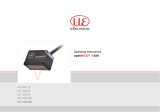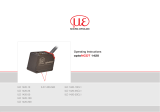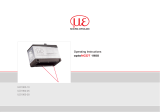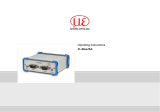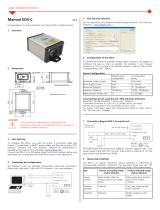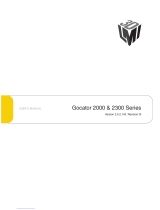Page is loading ...

Operating Instructions
thicknessSENSOR
10/200
10/400
25/200
25/400

MICRO-EPSILON
MESSTECHNIK
GmbH & Co. KG
Königbacher Strasse 15
94496 Ortenburg / Germany
Phone +49 (0) 8542 / 168-0
Fax +49 (0) 8542 / 168-90
email [email protected]
www.micro-epsilon.com
Sensor for thickness measurement

thicknessSENSOR
Contents
1. Safety ........................................................................................................................................ 5
1.1 Symbols Used ................................................................................................................................................. 5
1.2 Warnings .......................................................................................................................................................... 5
1.3 Notes on CE Marking ...................................................................................................................................... 5
1.4 Intended Use ................................................................................................................................................... 6
1.5 Foreseeable Misuse ......................................................................................................................................... 6
1.6 Proper Environment ......................................................................................................................................... 6
2. Laser Class ............................................................................................................................... 7
3. Functional Principle ................................................................................................................. 8
3.1 Base Frame ...................................................................................................................................................... 8
3.2 Sensors ........................................................................................................................................................... 9
3.3 Calibration Target ............................................................................................................................................. 9
3.4 Technical Data ............................................................................................................................................... 10
4. Delivery ................................................................................................................................... 11
4.1 Unpacking /Included in Delivery ................................................................................................................... 11
4.2 Storage .......................................................................................................................................................... 11
5. Mounting ................................................................................................................................. 12
5.1 General .......................................................................................................................................................... 12
5.2 Error Influences ............................................................................................................................................. 12
5.2.1 Ambient Light ............................................................................................................................... 12
5.2.2 Color Differences ......................................................................................................................... 12
5.2.3 Surface Roughness ..................................................................................................................... 12
5.2.4 Temperature Influences ............................................................................................................... 12
5.2.5 Movement Blurs ........................................................................................................................... 12
5.2.6 Optimizing the Measuring Accuracy ........................................................................................... 13
5.3 Mechanical Fastening, Dimensional Drawing ............................................................................................... 14
5.4 Control and Display Elements ....................................................................................................................... 18
5.5 Electrical Connections ................................................................................................................................... 18
5.5.1 Connection Possibilities ............................................................................................................... 18
5.5.2 Pin Assignment ............................................................................................................................. 19
5.5.3 Power Supply ............................................................................................................................... 19
5.5.4 Current Output .............................................................................................................................. 19
5.5.5 Voltage Output .............................................................................................................................. 20
5.5.6 Trigger, Master Function Inputs .................................................................................................... 20
5.5.7 Switching Outputs ........................................................................................................................ 20
5.5.8 Connector and Sensor Cable....................................................................................................... 21
6. Operation ................................................................................................................................ 22
6.1 Getting Ready for Operation ......................................................................................................................... 22
6.2 Operation Using Ethernet .............................................................................................................................. 22
6.2.1 Requirements ............................................................................................................................... 22
6.2.2 Access via Ethernet ...................................................................................................................... 23
6.2.3 Measured Value Display with Web Browser ................................................................................ 25
6.3 Home Menu ................................................................................................................................................... 26
6.4 Preferences Menu .......................................................................................................................................... 27
6.4.1 Language Selection...................................................................................................................... 27
6.4.2 Sensors ......................................................................................................................................... 27
6.4.3 Measuring Rate ............................................................................................................................ 28
6.4.4 Filter / Averaging / Error Handling Inside thicknessSENSOR ..................................................... 29
6.4.5 Zeroing / Mastering ...................................................................................................................... 31
6.4.6 Digital Interfaces ........................................................................................................................... 32
6.4.6.1 Selection of Digital Interfaces ..................................................................................... 32
6.4.6.2 Data Selection ............................................................................................................. 33
6.4.6.3 Ethernet Settings ......................................................................................................... 34
6.4.7 Analog Outputs............................................................................................................................. 35
6.4.7.1 Analog Output 1 and 2 ................................................................................................ 35
6.4.8 Digital Ports .................................................................................................................................. 37
6.4.8.1 Digital Input ................................................................................................................. 37
6.4.8.2 Digital Outputs ............................................................................................................. 37
6.4.9 Output Data Rate .......................................................................................................................... 38
6.4.10 Trigger Mode ................................................................................................................................ 39
6.4.11 Load/Save Settings ...................................................................................................................... 40
6.4.12 Manage Settings on PC ............................................................................................................... 41
6.4.13 Extras ............................................................................................................................................ 43
6.4.13.1 Language .................................................................................................................... 43
6.4.13.2 Factory Defaults .......................................................................................................... 43
6.4.13.3 Reset of Controller ...................................................................................................... 44
6.5 Measuring Menu ............................................................................................................................................ 45
6.6 Help/Info Menu .............................................................................................................................................. 47
7. Software Support with MEDAQLib ........................................................................................ 48
8. Liability for Material Defects .................................................................................................. 49
9. Service, Repair ...................................................................................................................... 49
10. Decommissioning, Disposal .................................................................................................. 49

thicknessSENSOR
Appendix
A 1 Accessories ............................................................................................................................ 50
A 2 Factory Defaults ..................................................................................................................... 51
A 2.1 Home ............................................................................................................................................................. 51
A 2.2 Sensors .......................................................................................................................................................... 51
A 2.3 Measuring Rate .............................................................................................................................................. 51
A 2.4 Filter / Averaging / Error Handling inside thicknessSENSOR ....................................................................... 51
A 2.5 Zeroing/Mastering.......................................................................................................................................... 51
A 2.6 Digital interfaces ............................................................................................................................................ 51
A 2.7 Analog Outputs .............................................................................................................................................. 51
A 2.8 Digital Ports .................................................................................................................................................... 52
A 2.9 Output Data Rate ........................................................................................................................................... 52
A 2.10 Trigger Mode .................................................................................................................................................. 52
A 2.11 Load/Save Settings ........................................................................................................................................ 52
A 2.12 Extras ............................................................................................................................................................. 52
A 3 Pin Assignment ...................................................................................................................... 53
A 4 ASCII Communication with the Sensor ................................................................................. 54
A 4.1 General .......................................................................................................................................................... 54
A 4.2 Data Protocol ................................................................................................................................................. 54
A 4.3 Commands Overview .................................................................................................................................... 57
A 4.4 Commands .................................................................................................................................................... 58
A 4.4.1 Controller Information ................................................................................................................... 58
A 4.4.2 Search Sensor .............................................................................................................................. 58
A 4.4.3 Sensor Information ....................................................................................................................... 58
A 4.4.4 Read all Settings ........................................................................................................................... 58
A 4.4.5 Language Setting ......................................................................................................................... 58
A 4.4.6 Synchronization ............................................................................................................................ 59
A 4.4.7 Boot the Controller ....................................................................................................................... 59
A 4.4.8 Triggering ...................................................................................................................................... 59
A 4.4.8.1 Trigger Selection
A 4.4.8.2 Trigger Level
A 4.4.8.3 Number of Measured Values to be Output
A 4.4.8.4 Software Trigger Pulse
A 4.4.9 Ethernet ........................................................................................................................................ 60
A 4.4.10 Setting the Measured Value Server .............................................................................................. 60
A 4.4.11 Transmission Rate ........................................................................................................................ 60
A 4.4.12 Save Parameters .......................................................................................................................... 60
A 4.4.13 Load Parameters .......................................................................................................................... 60
A 4.4.14 Factory defaults ............................................................................................................................ 60
A 4.4.15 Measurement Mode ..................................................................................................................... 61
A 4.4.16 Measuring Rate ............................................................................................................................ 61
A 4.4.17 Measured Value Averaging Controller ......................................................................................... 61
A 4.4.18 Measured Value Averaging Sensor .............................................................................................. 61
A 4.4.19 Mastering / Zeroing ...................................................................................................................... 61
A 4.4.20 Selection Digital Output................................................................................................................ 61
A 4.4.21 Output Data Rate .......................................................................................................................... 62
A 4.4.22 Scale Output Values ..................................................................................................................... 62
A 4.4.23 Error Handling .............................................................................................................................. 62
A 4.4.24 Data Selection for USB ................................................................................................................. 62
A 4.4.25 Data Selection for Ethernet .......................................................................................................... 63
A 4.4.26 Function Selection Multi-function Input........................................................................................ 63
A 4.4.27 Activate Error Output, Switching Output 1 ................................................................................... 63
A 4.4.28 Activate Error Output, Switching Output 2 ................................................................................... 63
A 4.4.29 Limit Values................................................................................................................................... 64
A 4.4.30 Data Selection ............................................................................................................................. 64
A 4.4.31 Output Area .................................................................................................................................. 64
A 4.4.32 Two-point Scaling ......................................................................................................................... 64
A 4.4.33 Send Command to Connected Sensor........................................................................................ 65
A 4.4.34 Laser off / Laser on ....................................................................................................................... 65
A 4.4.35 Find thicknessSENSOR................................................................................................................ 65
A 4.5 Error Values via USB...................................................................................................................................... 65
A 4.6 Error Values via Ethernet ............................................................................................................................... 65

Page 5
Safety
thicknessSENSOR
1. Safety
The handling of the system assumes knowledge of the instruction manual.
1.1 Symbols Used
The following symbols are used in this instruction manual.
Indicates a hazardous situation which results in minor or mode-
rate injuries if not avoided.
NOTICE
Indicates a situation that may result in property damage if not
avoided.
Indicates a user action.
i
Indicates a tip for users.
Measure
Indicates hardware or a software button/menu.
1.2 Warnings
Avoid unnecessary laser radiation to be exposed to the human body.
Switch off the sensor for cleaning and maintenance.
Switch off the sensor for system maintenance and repair if the sensor is integrated
into a system.
Caution - use of controls or adjustments or performance of procedures other than those
specified may cause harm.
Connect the power supply and the display / output device in accordance with the safety
regulations for electrical equipment.
> Risk of injury
> Damage to or destruction of the sensors, the controller
The power supply must not exceed the specified limits.
> Risk of injury
> Damage to or destruction of the sensors, the controller
Avoid shocks and impacts to the sensors, the mechanics.
> Damage to or destruction of the sensors, the controller
Do not clean the protective glass of the sensors with water.
> Damage to the protective glass
1.3 Notes on CE Marking
The following apply to the thicknessSENSOR:
- EU Directive 2014/30/EU,
- EU Directive 2011/65/EU, “RoHS” Category 9
Products which carry the CE mark satisfy the requirements of the EU directives cited and
the European harmonized standards (EN) listed therein. The EU Declaration of Conformi-
ty is available to the responsible authorities according to EU Directive, article 10, at:
MICRO-EPSILON MESSTECHNIK
GmbH & Co. KG
Königbacher Straße 15
94496 Ortenburg / Germany
The sensor is designed for use in industrial environments and meets the requirements.
NOTICE

thicknessSENSOR
1.4 Intended Use
- The thicknessSENSOR is designed for use in industrial and laboratory applications. It
is used for
thickness measurement
quality monitoring and dimensional inspection
profile measurement
- The sensor must only be operated within the limits specified in the technical data.
- The sensor must be used in such a way that no persons are endangered or machines
and other material goods are damaged in the event of malfunction or total failure of
the controller.
- Take additional precautions for safety and damage prevention in case of safety-related
applications.
1.5 Foreseeable Misuse
If the target/strip material flow has started, the calibration component holder may not be
retracted. Collision of the target/strip material with the calibration component holder.
During the reference measurement, the target/strip material flow may not be started.
Collision of the target/strip material with the calibration component holder.
1.6 Proper Environment
- Protection class: IP 65
- Operating temperature: 0 ... 50 °C (+32 ... +122 °F) (non-condensing)
- Storage temperature: -20 ... 70 °C (-4 ... +158 °F) (non-condensing)
- Humidity: 5 - 95 % (non-condensing)
- Ambient pressure: Atmospheric pressure
i
The protection class is limited to water (no penetrating liquids, detergents or similar
aggressive media). Use a protective housing in case of permanent exposure to
water.
Optical inputs are excluded from protection class. Contamination leads to impairment or
failure of the function.

Page 7
Laser Class
thicknessSENSOR
2. Laser Class
The sensors of the thicknessSENSOR operate with a semiconductor laser with a wave-
length of 670 nm (visible/red).
The sensors fall within Laser Class 2. The lasers are pulsed, the maximum optical power
is ≤1 mW. The pulse frequency depends on the set measuring rate (0.25 ... 4 kHz). The
pulse duration of the peaks is regulated depending on the measuring rate and the reflec-
tivity of the measurement object and can be 0.3 ... 3999.6 μs.
i
Observe the laser protection regulations.
When operating the sensors, the relevant regulations in accordance with DIN EN 60825-
1 (VDE 0837, Part 1 dated 07/2015) and the accident prevention instructions on laser
radiation (BGV B2 dated 01/1997) valid in Germany must be observed. Thereafter:
- With class 2 laser devices, the eye is not endangered by random, brief exposure to
laser radiation, i.e. exposure times of up to 0.25 s.
- Class 2 laser devices may therefore be used without further protective measures if
you do not intentionally look into the laser beam or in specularly reflected radiation for
more than 0.25 s.
- Because the presence of the eyelid protective reflex should not normally be assumed,
one should deliberately close the eyes or turn away immediately if the laser beam hits
the eye.
Class 2 laser devices are not subject to notification and a laser protection officer is not
required.
LASERSTRAHLUNG
NICHT IN DEN STRAHL BLICKEN
LASER KLASSE 2
nach DIN EN 60825-1: 2015-07
P 1mW; =670nm≤
LASER RADIATION
DO NOT STARE INTO THE BEAM
CLASS 2 LASER PRODUCT
IEC 60825-1: 2015-07
P 1mW;
=670nm≤
THIS PRODUCT COMPLIES WITH FDA
REGULATIONS 21CFR 1040.10 AND 1040.11
Fig. 1 Laser warning signs
Fig. 2 Laser warning
symbol
LASERSTRAHLUNG
NICHT IN DEN STRAHL BLICKEN
LASER KLASSE 2
nach DIN EN 60825-1: 2015-07
P 1mW; =670nm≤
LASER RADIATION
DO NOT STARE INTO THE BEAM
CLASS 2 LASER PRODUCT
IEC 60825-1: 2015-07
P 1mW;
=670nm≤
THIS PRODUCT COMPLIES WITH FDA
REGULATIONS 21CFR 1040.10 AND 1040.11
LASERSTRAHLUNG
NICHT IN DEN STRAHL BLICKEN
LASER KLASSE 2
nach DIN EN 60825-1: 2015-07
P 1mW; =670nm≤
LASER RADIATION
DO NOT STARE INTO THE BEAM
CLASS 2 LASER PRODUCT
IEC 60825-1: 2015-07
P 1mW;
=670nm≤
THIS PRODUCT COMPLIES WITH FDA
REGULATIONS 21CFR 1040.10 AND 1040.11
optoNCDT
optoNCDT
Fig. 3 Laser warning signs on the sensor
i
If both warning signs are hidden in the installed state, the user must ensure that
additional warning signs are fitted at the point of installation.
The operation of the laser is indicated by an LED on the sensor, see Chap. 5.4.
The housing of the laser-optical sensors may only be opened by the manufacturer, see
Chap. 8., see Chap. 9.
For repair and service purposes the sensors must always be sent to the manufacturer.
Do not look deliberate-
ly into the laser beam.
Close your eyes or
immediately turn away if
the laser beam hits the
eye.

Page 8
Functional Principle
thicknessSENSOR
3. Functional Principle
3.1 Base Frame
The sensor is used for the non-contact thickness measurement of non-transparent strips
and plates.
Target
Upper beam
Lower beam
Sensor 2
Sensor 1
Fig. 4 Schematic representation of the measuring machine
The measuring method of the unit is based on double-sided thickness measurement,
consisting of two laser-optical sensors, which measure the target from opposite posi-
tions. The thickness of the target is calculated in the integrated controller.
Controller
Sensor 2
Sensor 1
SMR 2SMR 1
Measurement
object
Input
2
Input
1
Fig. 5 Sensor arrangement for the thickness measurement
The thickness determination does not require any complex target support. The main
advantage is that vibrations of the target do not result in inaccurate measurement. The
positional tolerance of the target is determined from the working gap, the start of mea-
suring range (SMR), see Fig. 5, and the measuring range (MR) of the laser sensors, see
Fig. 6.
Working gap
MR
Target
Positional tolerance
target
Working gap
MR
Target
Positional tolerance
target
Working gap
MR
Target
Positional tolerance
target
Target in the MR,
measurement successful
Target outside of the MR,
measurement unsuccessful
Target partly in the MR,
measurement unsuccessful
No damage to the target/measuring machine
Fig. 6 Possible positions of the material to be measured and statements about the feasi-
bility of thickness measurement

Page 9
Functional Principle
thicknessSENSOR
3.2 Sensors
The two laser sensors measure without contact the thickness of the strips as they pass
between the two upper and lower belts of the measuring machine, see Fig. 4.
i
An air purge at the sensors reduces dust accumulation, etc. on the glass panes for
the laser and the receiver.
Laser beam output
Fig. 7 Lower belt with laser sensor
3.3 Calibration Target
For a reference measurement, a calibration target is used to detect deviations. The cal-
ibration target is 3.0 mm thick, it is attached to the upper belt if required and protrudes
into the measuring gap of the sensor. After the reference measurement, the calibration
target must be removed again.
Calibration Target
Fig. 8 Calibration target on the upper belt
i
Calibration measurement is recommended after temperature fluctuations, a me-
chanical shock of the thicknessSENSOR or after changing the target material.
Do not look deliberate-
ly into the laser beam.
Close your eyes or
immediately turn away if
the laser beam hits the
eye.

Page 10
Functional Principle
thicknessSENSOR
3.4 Technical Data
Model
thicknessSENSOR
10/200
thicknessSENSOR
10/400
thicknessSENSOR
25/200
thicknessSENSOR
25/400
Measuring range 10 mm 10 mm 25 mm 25 mm
Working gap 46 mm 46 mm 71 mm 71 mm
Measuring width 200 mm 400 mm 200 mm 400 mm
Linearity (combined) ±10 μm ±10 μm ±40 μm ±40 μm
Measuring rate 0.25 kHz / 0.5 kHz / 1 kHz / 2 kHz / 4 kHz
Light source Semiconductor laser <1 mW, 670 nm (red)
Permissible ambient light 10.000 lx
Light spot diameter max. 140 x 160 μm (±10 %) max. 390 x 500 μm (±10 %) max.
Protection class IP 65
Laser safety class Class 2 according to DIN EN 60825-1: 2015-07
Temperature stability ± 0.03 % FSO/°C
Operating temperature 0 ... +50 °C (+32 ... +122 °F) (non-condensing)
Storage temperature -20 ... +70 °C (-4 ... +158 °F) (non-condensing)
Control inputs/outputs 1 x trigger in / 1 x master / 2 x switching outputs
Measurement value output
0 - 5 V, 0 - 10 V, ±5 V, ±10 V, 4 - 20 mA
Ethernet
Vibration 2 g / 20 ... 500 Hz (according to IEC 60068-2-6)
Shock 15 g / 6 ms / 3 axes (according to IEC 60068-2-29)
Weight 3.3 kg 4.3 kg 3.5 kg 4.5 kg
Displays
Sensor 3x color LEDs for power and status
Controller Power i.o.
Operation
Web
interface
Selectable averages / data reduction / setup management / limit values
Power supply 11 - 30 V DC, 24 V P< 5 W
Controller Integrated signal processor, signal processing unit
Electromagnetic
compatibility (EMC)
EN 61 000-6-3 / DIN EN 61326-1 (class B)
EN 61 000-6-2 / DIN EN 61326-1
FSO = full scale output

Page 11
Delivery
thicknessSENSOR
4. Delivery
4.1 Unpacking /Included in Delivery
1 thicknessSENSOR
1 instruction manual
x inspection report(s) of the ILD sensors
Carefully remove the sensor parts from the packaging and ensure furthermore that
the goods are forwarded in such a way that no damage can occur.
Check the delivery for completeness and shipping damage immediately after un-
packing.
In case of damage or missing parts, please contact the manufacturer or supplier
immediately.
Optional accessories are available in the appendix, see Chap. A 1.
4.2 Storage
- Storage temperature: -20 ... 70 °C (+32 ... +122 °F) (non-condensing)
- Relative humidity: 5 ... 95 % (-4 ... +158 °F) (non-condensing)

Page 12
Mounting
thicknessSENSOR
5. Mounting
5.1 General
The thicknessSENSOR achieves linearity in the micrometer range. For this reason, the
mechanical components and sensors are matched to one another. Insofar as is con-
structively possible, mechanical assemblies and individual parts which are not subject
to adjustment have been used. Such parts/assemblies which have to be adjusted for
functional reasons have been adjusted by Micro-Epsilon.
The commissioning does not require any adjustment work by the customer. The custom-
er is responsible for providing a protective device to avoid a collision between the strip
material (target) and the thicknessSENSOR.
5.2 Error Influences
5.2.1 Ambient Light
Thanks to their integrated optical interference filters, the laser-optical sensors offer
outstanding performance in suppressing ambient light. However, ambient light distur-
bances can occur with shiny measurement objects and at a reduced measuring rate. In
these cases it is recommended to provide shielding against ambient light. This applies in
particular to measurement work performed in the vicinity of welding devices.
5.2.2 Color Differences
Because of intensity compensation, color difference of targets affect the measuring result
only slightly. However, such color differences are often combined with different penetra-
tion depths of the laser light into the material. Different penetration depths then result in
apparent changes of the measuring spot size. Therefore color changes in combination
with penetration depth changes may lead to measurement uncertainties.
5.2.3 Surface Roughness
In case of traversing measurements, surface roughnesses of 5 μm and more lead to an
apparent distance change (so-called surface noise). However, they can be dampened by
selecting a higher average.
5.2.4 Temperature Influences
When the sensor is commissioned, a warm-up time of at least 20 minutes is required to
achieve uniform temperature distribution in the sensor. If measurement is performed in
the μm accuracy range, the effect of temperature fluctuations on the sensor holder must
be considered. Due to the damping effect of the heat capacity of the sensor, sudden
temperature changes are only measured with delay.
5.2.5 Movement Blurs
If the objects being measured are fast moving and the measuring rate is low, it is possi-
ble that movement blurs may result. Therefore, always select a high measuring rate for
high-speed operations to prevent errors.

Page 13
Mounting
thicknessSENSOR
5.2.6 Optimizing the Measuring Accuracy
Color strips Direction of movement
Grinding and rolling marks
llaasseerr ooffff
iinn rraannggee
mmiiddrraannggee
eerrrroorr
ssttaattee
oouuttppuutt
sseelleecctt
In case of rolled or polished metals that are
moved past the sensor, the sensor plane must
be arranged in the direction of the rolling or
grinding marks. The same arrangement must
be used for color strips.
Fig. 9 Sensor arrangement for ground or striped
surfaces
optoNCDT
≤
≤
optoNCDT
False (shadow)
In case of bore holes, blind holes and edges in
the surface of moving parts, the sensor must
be arranged in such a way that the edge does
not obscure the laser spot.
Fig. 10 Sensor arrangement for holes and
edges

Page 14
Mounting
thicknessSENSOR
5.3 Mechanical Fastening, Dimensional Drawing
140 (.1)
93 (3.7)
(MR top) 75 (2.9)
(MR bottom) 65 (2.6)
47 (1.9)
0
M6x1 - 6H
(4x fastening thread)
0
135 (5.3)
105 (4.1)
45 (1.8)
15 (.6)
10 (.4)
0
3 (.1)
38 (1.5)
250 (.98)
410 (16.1)
427 (16.8)
M6x1 - 6H
(4x fastening thread)
0
25 (1)
47 (1.9)
115 (4.5)
0
25 (1)
115 (4.5)
0
35 (1.4)
70 (2.8)
104 (4.1)
70 (2.8)
55 (2.2)
42 (1.7)
20 (.8)
0
0
25.5(1)
(laser
beam)
35(1.4)
40 (1.6)
70 (2.8)
Fig. 11 Dimensional drawing thicknessSENSOR 10/200, dimensions in mm, not to scale

Page 15
Mounting
thicknessSENSOR
(MR top)75 (2.9)
(MR bottom)65 (2.6)
93 (3.7)
47 (1.9)
0
0
0
25 (1)
47
(1.9)
115
(4.5)
35 (1.4)
70 (2.8)
104 (4.1)
140 (.1)
M6x1 - 6H
(4x fastening
thread)
M6x1 - 6H
(4x fastening
thread)
(laser-
beam)
0
15 (.6)
45 (1.8)
105 (4.1)
135 (5.3)
627 (24.7)
10
(.4)
610 (24)
115 (4.5)
25 (1)
0
38 (1.5)
0
3 (.1)
0
20 (.8)
42 (1.7)
55 (2.2)
70 (2.8)
25.5 (1)
35 (1.4)
0
40 (1.6)
70 (2.8)
450 (17.7)
Fig. 12 Dimensional drawing thicknessSENSOR 10/400, dimensions in mm, not to scale

Page 16
Mounting
thicknessSENSOR
165 (6.5)
118 (4.6)
(MR top) 95 (3.7)
(MR bottom) 70 (2.8)
47 (1.9)
0
M6x1 - 6H
(4x fastening thread)
M6x1 - 6H
(4x fastening thread)
0
0
35 (1.4)
70 (2.8)
0
0
10
(.4)
0
37.5 (1.5)
47 (1.9)
127.5 (5)
0
15 (.6)
45 (1.8)
105 (4.1)
135 (5.3)
104 (4.1)
70 (2.8)
55 (2.2)
42 (1.7)
20 (.8)
3 (.1)
0
38 (1.5)
250 (.98)
410 (16.1)
427 (16.8)
25.5 (1)
35 (1.4)
40 (1.6)
70 (2.8)
Laser
beam
115 (4.5)
25 (1)
Fig. 13 Dimensional drawing thicknessSENSOR 25/200, dimensions in mm, not to scale

Page 17
Mounting
thicknessSENSOR
M6x1 - 6H
(4x fastening
thread)
10
(.4)
(Laser-
beam)
25.5 (1)
35 (1.4)
40 (1.6)
70 (2.8)
0
115 (4.5)
25 (1)
0
37.5 (1.5)
0
47 (1.9)
127.5 (5)
627 (24.7)
610 (24)
38 (1.5)
0
3 (.1)
(MR top) 95
(MR bottom) 70
118
47
0
165
0
20 (.8)
42 (1.7)
55 (2.2)
70 (2.8)
0
35 (1.4)
70 (2.8)
104 (4.1)
135 (5.3)
105 (4.1)
45 (1.8)
15 (.6)
0
M6x1 - 6H
(4x fastening
thread)
450 (17.7)
Fig. 14 Dimensional drawing thicknessSENSOR 25/400, dimensions in mm, not to scale

Page 18
Mounting
thicknessSENSOR
5.4 Control and Display Elements
LED State Meaning
LED state
LED
output
green Target within the measuring range
yellow Target within the midrange
red
Error, e.g. target outside the measuring
range, too low reflection
off Laser switched off
LED Output Meaning
green RS422 measured value output
yellow
RS422 and current output are switched off.
The RS422 and the current output can be
switched on.
The web interface can be switched on.
red Measured value output current 4 ... 20 mA
off Sensor off, no supply
The Select key is disabled.
5.5 Electrical Connections
5.5.1 Connection Possibilities
Source Cable/Supply Terminal
PC
Dig I/O, Analog out
PS 2020
PS2020
Ethernet
SCD1420-x/THS
PC1420-x/THS
Fig. 15 Connection examples on ILD 1420
Different periphery devices can be connected to the 12-pin Analog Digital I/O 24
VDC connector, see Fig. 15. Power is supplied e.g. by the optionally available power
supply PS 2020, see A 1.

Page 19
Mounting
thicknessSENSOR
5.5.2 Pin Assignment
Pin Color sensor cable, explanation Note
12
9
8
7
1
2
3
4
5
6
11
10
Solder side cable
connector
9 red Operating voltage
11 ... 30 VDC,
typ. 24 VDC, P< 5 W
2 blue GND, supply Power supply ground
3 white Trigger input
4 green Master input
5 pink Switching output 1
6 yellow Switching output 2
7 black GND, switching outputs
8 gray Voltage output 1
10 violet Voltage output 2
11 gray-pink GND, analog
1 brown Current output 1
12 red-blue Current output 2
Housing, shield Connect to potential equalization
Fig. 16 Pin assignment of the 12-pin connector “Analog Digital I/O 24 VDC”
Please refer to the pin assignment diagram for further information, see Chap. A 3.
5.5.3 Power Supply
Nominal value: 24 V DC (11 ... 30 V, P < 5 W).
Switch on the power supply only after completing the wiring.
Connect the inputs “9” and “2” at the sensor with a 24V power supply.
Use the power supply unit for measurement devices only and not for drive units or simi-
lar sources of pulse interference at the same time.
Sensor
9
2
11 ... 30
VDC
thickness
SENSOR
MICRO-EPSILON
recommends us-
ing the optionally
available power
supply PS2020 for
the sensor, see
chapter A 1.
12-pin M12 ca-
ble connector
Sensor cable
9 red +U
B
2 blue GND
Fig. 17 Power supply connection
5.5.4 Current Output
The sensor provides a current output of 4 ... 20 mA.
i
The current output may not be continuously operated in short-circuit operation with-
out load resistor. Permanent short-circuit operation leads to thermal overload and
thus to the automatic overload cut-off of the output.
Connect the output 1 or 12 (brown or red-blue) and 11 (gray-pink) at
the sensor with a measurement device.
Sensor
1/12
11
thickness
SENSOR
I
out
12-pin M12 ca-
ble connector
Sensor cable
1 or 12
brown or
red-blue
I
OUT1
I
OUT2
11 gray-pink GND
Fig. 18 Wiring for current output

Page 20
Mounting
thicknessSENSOR
5.5.5 Voltage Output
The sensor provides a voltage output. Variants: 0 ... 5 V, 0 ... 10 V, ±5 V, ±10 V.
Connect the output 8 or 10 (gray or violet) and 11 (black) at the sensor
with a measurement device.
Sensor
8/10
11
thickness
SENSOR
U
out
12-pin M12 ca-
ble connector
Sensor cable
8 or 10
gray or
violet
U OUT1
U OUT2
11 black GND
Fig. 19 Wiring for voltage output
5.5.6 Trigger, Master Function Inputs
The inputs on the 12-pin M12 cable connector enable the triggering and zeroing/master-
ing functions. The function depends on the programming of the input.
- Pin 3 Trigger input
- Pin 4 Zeroing/Master input
+U
B
+U
B
Sensor cable
blue
Variant 1 Variant 2
white resp.
green
3/4
2
thickness
SENSOR
Low-level logic (LLL)
≤0.7 V: Low level
≥2.2 V: High level
High-level logic (HLL)
≤3.0 V: Low level
≥8.0 V: High level
Internal pull-down resistor, an open
input is detected as Low.
Fig. 20 Basic circuit for the function inputs
Connect the input to +U
B
to trigger the function.
5.5.7 Switching Outputs
The switching characteristic of the push-pull error outputs on the 12-pin M12 cable con-
nector depends on the programming.
5/6
+U
B
thickness
SENSOR
7
High-level logic (HLL)
≤3.0 V: Low level
(at I
max
= 40 mA)
≥+UB - 3V: High level
(at I
max
= 40 mA)
I
max
= 40 mA,
Fig. 21 Basic circuit for the error output
Switching characteristic
Description Output active
(error)
Output passive
(no error)
Push-Pull + U
B
- 3V (at I
max
= 40 mA) ≤3.0 V (at I
max
= 40 mA)
Fig. 22 Switching characteristic for error output
Error output is activated e.g. when the measurement object is missing, it is too close/too
far or when no valid measurement value can be determined.
/



